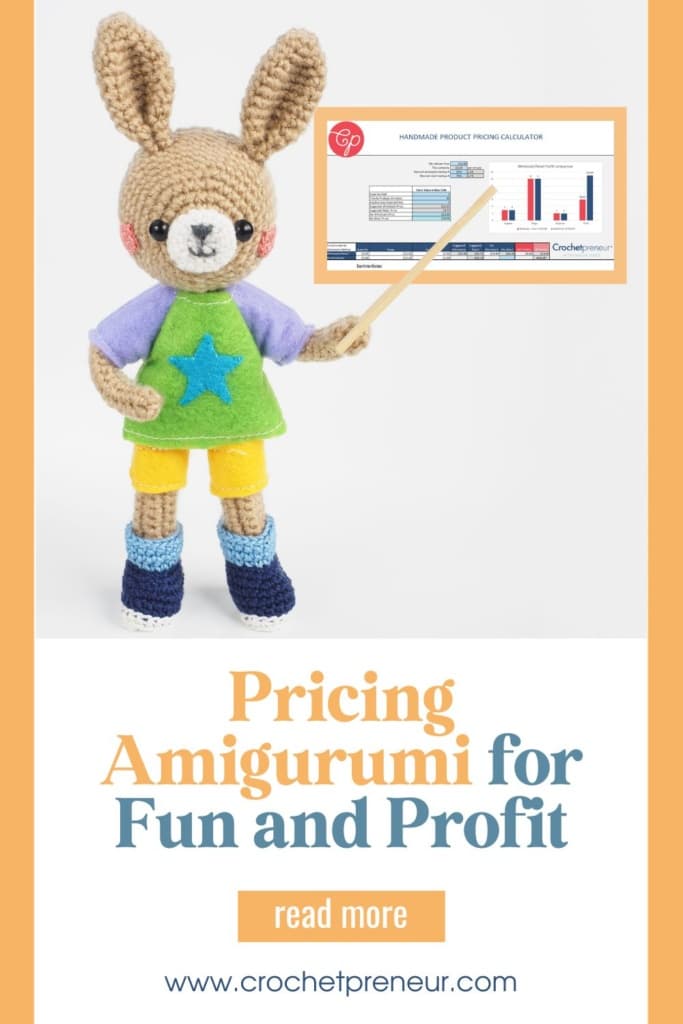Pricing amigurumi is one of the biggest struggles for ami crocheters who want to be profitable. Don’t worry, we’ve got you covered. In this episode of Crochet Business Chat (outlined below if you don’t want to watch or listen), we will delve into the crucial topic of pricing Amigurumi and how it affects the profitability of your crochet business. As a business coach, business strategist, and marketer, I will share valuable insights and practical tips to help you set the right prices for your products. So, grab your hook and let’s get started!

Understanding Profit when Pricing Amigurumi
Profit is a fundamental aspect of any successful business. It goes beyond simply covering the cost of supplies and paying yourself for your time. Profit is what’s left after all expenses have been taken care of, including reinvesting in your business and paying yourself a fair wage. Neglecting to consider profit in your pricing strategy can hinder your business’s growth and sustainability.
👩🏫 For guidance on using the Profit First model in your business, grab your very own copy of (affiliate link), “Profit First” by Mike Michalowicz.
Setting a Fair Wage for Your Skills and Talents
As a talented crochet artist, it’s crucial to value your skills and time appropriately. Paying yourself a fair wage reflects your experience, expertise, and the quality of your work. Whether you’re a newbie or a seasoned crochetpreneur, it’s important to take into account your skill level and brand reputation when determining your hourly wage. Remember, your work deserves more than just minimum wage!
Other Factors to Consider in Your Pricing Strategy
To create a pricing strategy that makes sense, it’s important to consider several key factors. Here are some essential points to include:
- Cost of Supplies: Calculate the exact amount you spend on materials for each Amigurumi creation. This includes yarn, stuffing, safety eyes, embroidery thread, and any other materials used.
- Time Spent: Estimate the time it takes to complete each stuffie, from start to finish. This includes the time spent on crocheting, sewing, stuffing, and adding any intricate details.
- Hourly Wage: Determine the hourly wage you believe is fair for your level of expertise and the quality of your work. Be sure to align your wage with your skill level and brand reputation.
- Business Expenses: Account for all the general business expenses related to your crochet venture. This includes licensing fees, website maintenance costs, booth setup expenses for craft shows, and shipping supplies. – then estimate a per-piece cost to add to your pricing strategy.
- Markup for Profit and Salary: Decide on the profit margin that aligns with your business goals. This includes the amount you wish to set aside as owner’s salary and the additional profit you want to reinvest in your business (or put in your pocket). Remember, profit is crucial for business growth and sustainability.
👩🏫 For a more detailed breakdown of the “why” behind my pricing strategy, check out our article on “How to Price Crochet Products for Profit.“
Utilize a Pricing Calculator
To simplify the process of determining your pricing, various pricing calculators are available. These tools assist you in calculating the cost of supplies, time spent, your fair wage, and business expenses. Consider using free online calculators or ones specifically designed for crochet businesses, such as my free Handmade Product Pricing Calculator.

special designed for handmade sellers
Get Your Product Pricing Calculator
Opt to price your products based on time, stitches, or yardage and find the suggested retail and wholesale prices PLUS get graphic charts showing your per-product profits. It’s an indispensable tool for all handmade sellers!
Consistency is Key
Once you have settled on a pricing strategy that works for you, consistency is essential. Consistent pricing builds trust with your customers and helps establish your brand’s value. Stick to your chosen pricing model and make adjustments only when necessary. This strategic approach to pricing ensures transparency and professionalism in your business dealings.
Conclusion
Pricing your Amigurumi products may seem daunting at first, but with the right approach, having a strategy can be a powerful tool for driving profitability and growth in your crochet business. Remember to consider profit, pay yourself a fair wage, and account for all relevant factors in your pricing strategy. Utilize pricing calculators to simplify the process, and maintain consistency to build trust with your customers. By making informed decisions about your pricing, you can create a sustainable and successful crochetpreneur journey.
Happy crocheting, and may your business flourish!








